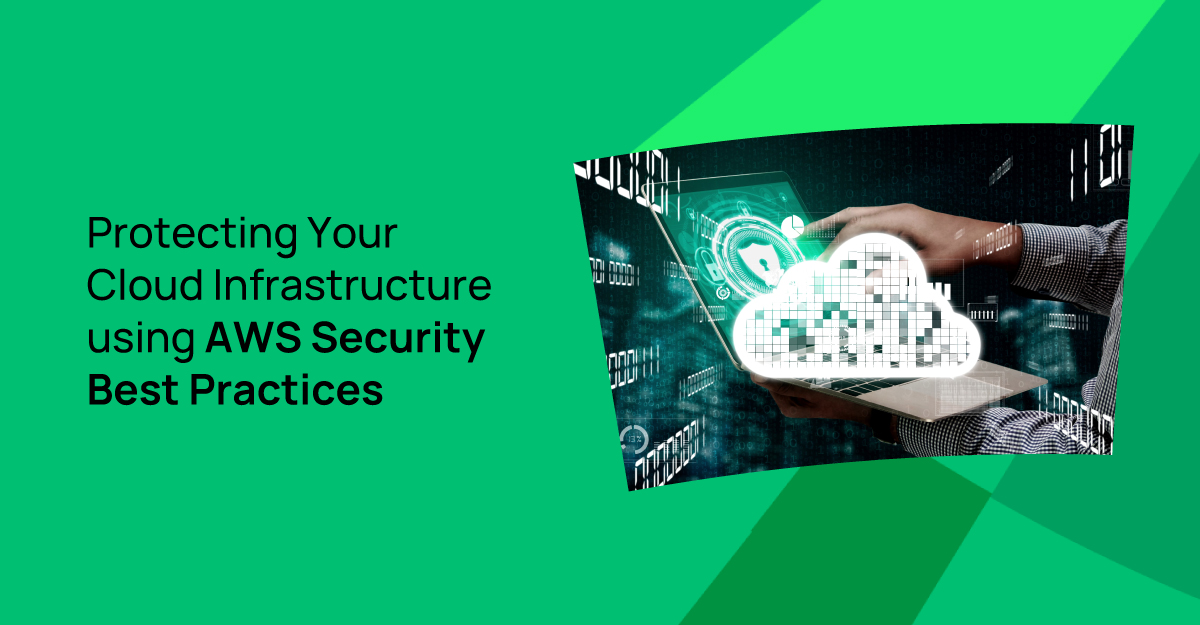To protect your data and ensure the availability and integrity of your AWS resources, it is essential to secure your cloud infrastructure. Let’s discuss AWS security recommended practices in this blog that will help you in strengthening your cloud infrastructure.
You may reduce the risk of security breaches and improve the overall security posture of your AWS infrastructure by putting these measures into effect.
What is AWS Cloud Security?
The AWS cloud security comprises the set of controls and measures that has been pre-installed in the cloud to safeguard the business infrastructure. It operates on a shared responsibility model: AWS protects the infrastructure of the cloud (servers, networking, data centers) and the customer protects the services hosted on the cloud (data, applications, configurations).
The security services provided by Amazon, mainly IAM, encryption, and key management, are indispensable in the process of developing security policies for your company. Compliance with laws and guidelines is also a key aspect, as non-compliance can have serious consequences.
Why Is Strong AWS Security Important?
The shared responsibility model means that AWS and clients both have roles to play in terms of security. AWS has to take strong security measures such as network firewall, encryption, and control of underlying infrastructure. As for customers, they need to regulate access to their information, to deal with the security of applications, to put appropriate mechanisms of authentication into practice, and to perform safe copies or backups of their data periodically.
Being aware of such responsibilities and fulfilling them collectively makes the cloud environment less vulnerable to potential threats and generally more secure.
Understanding the AWS Shared Responsibility Model
Let’s first start with the AWS Shared Responsibility Model to understand the security practices. AWS adopts a shared security model whereby AWS secures the cloud while the customer secures the cloud. This means AWS is responsible for the security management of the infrastructure while the customer is held accountable for the data, application, and configurations in the cloud.
AWS Security Best Practices
1. Understand All of Your Resources
Cloud assets cover all application workloads involving computation, storage, networking, and a wide range of managed services. They are not just to compute instances, often known as virtual machines.
The first step in securing your cloud environment is to comprehend and keep an accurate inventory of your Amazon assets with the right asset management solution. Organizations often erratically lose track of assets operating in their AWS accounts due to the dynamic nature of cloud computing, which can expose them to risk and invite assaults on unprotected resources. Accounts that were established early in an organization's cloud journey might not always have the common security controls that were added later.
2. Implement Identity and Access Management (IAM)
IAM is the core of AWS security. Because AWS provides a comprehensive platform to manage user identity and their permissions to AWS resources, the risk of unauthorized access and least privilege can be eliminated. Follow these best practices:
- Use Strong Password Policies: Implement good password practices such as length, composition, change frequency.
- Implement Multi-Factor Authentication (MFA): force users to use more complex passwords and a second level of authentication for example a token or SMS.
- Practice Least Privilege: Apply the rule of least privilege when delegating permissions, giving the minimum amount of rights that users need to accomplish their assignments.
3. Securing Data with Encryption
Encryption is the key used to safeguard your data that resides in various AWS services. Follow these encryption best practices:
- Enable Encryption at Rest: Extend AWS KMS key management techniques to encrypt Amazon EBS volumes, Amazon S3 buckets, and Amazon RDS databases.
- Encrypt Data in Transit: Employ SSL/TLS to secure the communication between client and AWS services to ensure confidentiality of data from being tampered with.
4. Monitoring and Logging for Security Insights
Security monitoring and logging enable you to keep an eye on your AWS environment to ensure you quickly mitigate potential threats. Consider these practices:
- Enable AWS CloudTrail: AWS CloudTrail is a service that logs all API calls made to your AWS account and establishes a history of events for auditing and investigating purposes.
- Implement AWS Config: AWS Config automatically audits and stores historic configurations of AWS resources to help you identify deviations from allowed configurations or unauthorized changes.
5. Protecting Against DDoS Attacks
DDoS attacks can interrupt your AWS services and impact your operations. Implement these measures to mitigate DDoS attacks:
- Use AWS Shield: AWS Shield offers defense against DDoS attacks by identifying and blocking malicious traffic that is aimed at your AWS resources.
- Leverage AWS WAF: AWS Web Application Firewall (WAF) is designed to protect web applications from common web exploits and DDoS attacks by filtering and monitoring HTTP requests.
6. Automating Security with AWS Security Services
Amazon web services provide several security services and security features that can assist in automating security tasks and improving the security posture of your organization. Consider these automation best practices:
- Utilize AWS Security Hub: Security Hub is an AWS security service that enables you to view your security state across each of your AWS accounts and perform continuous security checks and compliance.
- Implement AWS Config Rules: Config Rules is a feature that allows for creating security policies for your AWS resources and automatically evaluates and corrects compliance.
Conclusion
Building a secure cloud infrastructure on AWS involves the use of identity and access management, data encryption, logging and alerts, security groups and DDoS protection, and automation. Through following these AWS security best practices and actively combating new threats to the cloud, businesses can solidify their cloud castles and protect their most valuable possessions in the AWS cloud. Remember, security is a process, not a destination



